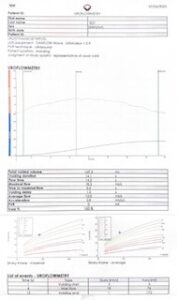Do I have the toy for you guys! Ever wondered how fast you urinate? When seeing foam in the bowl is not enough… Remember those days when we could see who urinated the furthest… I am obviously referring to your childhood, out in the bush or garden with your mates, and on the odd occasion of taking a leak at the same time, it would always end in a competition (boys will be boys). Hopefully you have outgrown this as it is probably not socially acceptable to do this anymore. We do experience a bit of this in public toilets occasionally with younger blokes urinating next to you, taking you back down memory-lane to the good-old days.
I generally ask the guys how fast their flow is. I occasionally get a puzzled look… My response would be: “Can you still wee over the fence, or do you wet your shoes? Can you still put foam in the bowl?” There is purpose in the question: A flow rate reveals a lot about a man’s lower urinary tract health. This forms part of the assessment your LUTS (lower urinary tract symptoms). LUTS consist of voiding symptoms and storage symptoms. A slow flow, interrupted flow, stop-start and inability to empty completely are your voiding symptoms. The storage symptoms are urgency, frequency, urge incontinence and urinating more than once a night. These are more prevalent with a bladder issue (overactive bladder) or significant outflow obstruction irritating your bladder. You could also have an overflow incontinence caused by the longstanding obstruction, whether it’s your prostate or a neurological (nerve) issue.
Pre-requirements for a Flowrate is a full bladder with a minimum of 150 cc present in the bladder. For this test, you will urinate into a special funnel that is connected to a measuring device. The device calculates the amount of urine, rate of flow in seconds, and the length of time until all urine has been passed. This information helps evaluate how well the lower urinary tract is working. It also helps figure out if there is a blockage of normal urine outflow. I look at the shape of the curve created on a graph. There a many tell-tale signs in this one examination. Once the flow rate is completed, I do an ultrasound to check how much urine remains in your bladder. I then have a wealth of information regarding the function of your bladder. This assists in decision making in the management of your urological issue. 
A Normal flow rate averages between 11-20ml/s. As you age over 50 your flow rate deteriorates. The flow rate should have a nice bell-curve. Usually, you would empty your bladder in less than 60 seconds. The average bladder volume is 600cc. Residual urine volumes vary with age and gender and should be as low as possible. A value between 100-150 cc is acceptable over the age of 60.
Results from a study published in the Indian Journal of Urology. Flow rates (Qmax values) in adult males were significantly higher than in the elderly and Qmax values in young females were significantly higher than in young males. Qmax values in males increased with age until 15 years old; followed by a slow decline until reaching 50 years old followed by a rapid decline after 50 years old even after correcting voided volume. Qmax values in females increased with age until they reached age 15 followed by decline in flow rate until a pre-menopausal age followed by no significant decline in post-menopausal females. Qmax values increased with voided volume until 700 cc followed by a plateau and decline. (Age, gender, and voided volume dependency of peak urinary flow rate and uroflowmetry nomogram in the Indian population – PMC (nih.gov)
Mean maximum and average flow rate parameters in different age group.
| Male population | Maximum flow rate | Average flow rate |
|
|
||
| 16-50 years old | 22.8 ml/sec | 13.22ml/sec |
| >50 year | 17.04 ml/sec | 8.9ml/sec |
|
|
||
| Female population | Maximum flow rate | Average flow rate |
|
|
||
| Pre-menopausal | 21.8 ml/sec | 12 ml/sec |
| Post-menopausal | 17.59 ml/sec | 10.2 ml/sec |
|
|
||
| Pediatric population | Maximum flow rate | Average flow rate |
|
|
||
| Girls | 19.33 ml/sec | 11.25 ml/sec |
| Boys | 16.9 ml/sec | 9.6 ml/sec |
Factors influencing your flow rate:
- Benign prostatic hypertrophy (BPH). This is enlargement of the prostate gland. It is not caused by cancer and often happens in men over age 50. The prostate wraps around the urethra. When it is enlarged, it can narrow the urethra and interfere with normal passage of urine from the bladder. If left untreated, the enlarged prostate can block the urethra completely.
- Cancer of the prostate or bladder
- Urinary blockage. A urinary tract blockage can happen for many reasons along any part of the urinary tract, from the kidneys to the urethra. It can lead to a urine backup. This can cause infection, scarring, or even kidney failure if untreated.
- Neurogenic bladder dysfunction. This is trouble with bladder function due to a nervous system problem, such as a spinal cord tumor or injury.
- Frequent urinary tract infections. These can cause scarring and damage in the urinary tract.
- Urine Flow Test | Johns Hopkins Medicine
What do I use it for:
- Diagnosis of an outflow obstruction.
- Assess the outcome of interventions: medical or surgical.
- With addition of Urodynamic studies, functional and neurogenic bladder issues can be managed appropriately.
So, guys come see me with your full bladders at the Wesley Hospital in Brisbane. Let’s see how well and effective you urinate, and then discuss how we can get you back to care-free urinating. The good old days.

Recent Comments